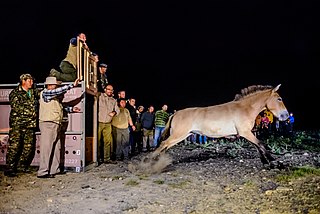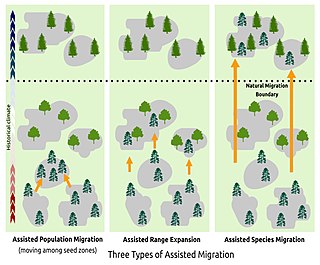Practical Applications

Seed transfer guidelines
The use of provenancing is important for seed transfer guidelines in the field of forestry and ecological restoration, as it is important to match planting sites with well-adapted seed provenances to develop healthy, productive plantings. Seed transfer guidelines establish general rules that apply when planting on sites where the species naturally occurs, but may also establish rules for specific species. They also establish seed transfer zones, which are areas within which plant materials can be transferred with little risk of maladaptation due to climatic similarities. [12] Seed transfer zones consider the distinctive habitats that are found within the range of a species, and are divided up based on this since certain individuals within the species are better suited for that site. [12] They may also consider genetic differences among populations, assuming that local populations are best adapted to their local environment. [13] The size of a tree seed zone can range from a few thousand acres to many thousand square miles since differences in topography influence the quantity of environmental heterogeneity seen in an area. [13]
Historically, tree seed zone maps were based on climatic, topographic, and vegetative information, assigning the general transfer guidelines and seed zones to all species. [13] However, it is now recognized that species differ in their response to general seed zones due to genetic differences and environmental influences. For example, forest tree species exhibit large genetic differences in survival, growth rate, frost hardiness, and other traits. [13] Thus, tree seed zones and transfer guidelines are now assigned for specific forest tree species by the US Forest Service, in addition to general guidelines that apply when planting on seed zones where the species naturally occurs. [13]
Development of seed transfer zones
Because it is difficult to gather comprehensive geo-genetic data for each species used in a restoration project due to time and resource constraints, there are different types of seed transfer zones developed for restoration projects. Some types of seed transfer zones are broadly apply to all plant species, while others apply to a specific species if enough data is available. Of these types of seed transfer zones are provisional, climate-matched, and empirical seed transfer zones.
Provisional seed transfer zones
Provisional seed transfer zones are the most generalized seed zones, and can be applied to any plant species to guide seed plantings; they are used when there is not any genetic information available for a species of interest. [14] They use geospatial climate data to derive regions of relative climatic similarity, predicting regions of local adaptation across a climate gradient. [14]
Climate-based seed transfer zones
Climate-based seed transfer zones provide species-specific guidance for seed zones, utilizing both species-distribution models and climatic information to predict the relative performance of seed at the target site. [15] Because these seed transfer zones apply to specific species, they can decrease the number of estimated seed sources per species needed, helping managers balance both ecological and economic considerations. [15]
Empirical seed transfer zones
Empirical seed transfer zones are the most accurate seed transfer zones for species-specific guidance since are derived from empirical data gathered from field-based experiments. [16] In the development of these seed zones, provenance trials are used to identify provenances that are well-adapted to the target region, which are common-garden experiments that evaluate plants for morphology, phenology, production, and physiological related traits. [17] With this data, statistical analyses are applied to develop models that link genetic variation across the target region, allowing seed zones to be assigned. [15]
- 1 2 3 4 5 6 7 8 9 Breed, Martin F; Harrison, Peter A; Bischoff, Armin; Durruty, Paula; Gellie, Nick J C; Gonzales, Emily K; Havens, Kayri; Karmann, Marion; Kilkenny, Francis F; Krauss, Siegfried L; Lowe, Andrew J; Marques, Pedro; Nevill, Paul G; Vitt, Pati L; Bucharova, Anna (2018-07-01). "Priority Actions to Improve Provenance Decision-Making". BioScience. 68 (7): 510–516. doi:10.1093/biosci/biy050. ISSN 0006-3568.
- ↑ Bucharova, Anna; Durka, Walter; Hölzel, Norbert; Kollmann, Johannes; Michalski, Stefan; Bossdorf, Oliver (December 2017). "Are local plants the best for ecosystem restoration? It depends on how you analyze the data". Ecology and Evolution. 7 (24): 10683–10689. Bibcode:2017EcoEv...710683B. doi:10.1002/ece3.3585. ISSN 2045-7758. PMC 5743477 . PMID 29299248.
- ↑ McKay, John K.; Christian, Caroline E.; Harrison, Susan; Rice, Kevin J. (September 2005). ""How Local Is Local?"—A Review of Practical and Conceptual Issues in the Genetics of Restoration". Restoration Ecology. 13 (3): 432–440. Bibcode:2005ResEc..13..432M. doi:10.1111/j.1526-100X.2005.00058.x. ISSN 1061-2971. S2CID 1267883.
- ↑ Mortlock, By Warren (August 2000). "Local seed for revegetation: Where will all that seed come from?". Ecological Management & Restoration. 1 (2): 93–101. Bibcode:2000EcoMR...1...93M. doi:10.1046/j.1442-8903.2000.00029.x. ISSN 1442-7001.
- 1 2 Broadhurst, Linda M.; Lowe, Andrew; Coates, David J.; Cunningham, Saul A.; McDonald, Maurice; Vesk, Peter A.; Yates, Colin (November 2008). "Seed supply for broadscale restoration: maximizing evolutionary potential". Evolutionary Applications. 1 (4): 587–597. Bibcode:2008EvApp...1..587B. doi:10.1111/j.1752-4571.2008.00045.x. ISSN 1752-4571. PMC 3352390 . PMID 25567799.
- 1 2 3 Breed, Martin F.; Stead, Michael G.; Ottewell, Kym M.; Gardner, Michael G.; Lowe, Andrew J. (February 2013). "Which provenance and where? Seed sourcing strategies for revegetation in a changing environment". Conservation Genetics. 14 (1): 1–10. Bibcode:2013ConG...14....1B. doi:10.1007/s10592-012-0425-z. ISSN 1566-0621. S2CID 254426835.
- ↑ Moritz, Craig (2004-05-06). "Conservation Units and Translocations: Strategies for Conserving Evolutionary Processes". Hereditas. 130 (3): 217–228. doi:10.1111/j.1601-5223.1999.00217.x.
- ↑ Lowe, Andrew (2015-02-21). "Local is Not Always Best". Biodiversity Revolution. Australian Centre for Evolutionary Biology and Biodiversity.
{{cite web}}: Missing or empty|url=(help) - ↑ Byrne, M; Prober, S; McLean, Liz; Steane, D; Stock, W; Potts, B; Vaillancourt, Rene (2013). Adaptation to Climate in Widespread Eucalypt Species. National Climate Change Adaptation Research Facility. ISBN 978-921609-98-5.
{{cite book}}: Check|isbn=value: length (help) - 1 2 Prober, Suzanne M.; Byrne, Margaret; McLean, Elizabeth H.; Steane, Dorothy A.; Potts, Brad M.; Vaillancourt, Rene E.; Stock, William D. (2015-06-23). "Climate-adjusted provenancing: a strategy for climate-resilient ecological restoration". Frontiers in Ecology and Evolution. 3. doi: 10.3389/fevo.2015.00065 . ISSN 2296-701X.
- ↑ Woolridge, Christopher B.; Fant, Jeremie B.; Flores, Ana I.; Schultz, Kelly; Kramer, Andrea T. (January 2023). "Variation in overall fitness due to seed source: projections for predictive provenancing". Restoration Ecology. 31 (1). Bibcode:2023ResEc..3113717W. doi:10.1111/rec.13717. ISSN 1061-2971.
- 1 2 "WWETAC TRM Seed Zone Mapping". www.fs.usda.gov. Retrieved 2024-03-10.
- 1 2 3 4 5 Randall, William; Berang, Paul (2002). Washington Tree Seed Transfer Zones (PDF). Washington State Department of Natural Resources.
- 1 2 Shryock, Daniel F.; DeFalco, Lesley A.; Esque, Todd C. (October 2018). "Spatial decision-support tools to guide restoration and seed-sourcing in the Desert Southwest". Ecosphere. 9 (10). doi:10.1002/ecs2.2453. ISSN 2150-8925.
- 1 2 3 "WWETAC TRM Seed Zone Mapping". www.fs.usda.gov. Western Wildland Environmental Threat Assessment Center - US Forest Service. Retrieved 2024-03-12.
- ↑ "Seed Transfer Zones". Colorado Plateau Native Plant Program. Bureau of Land Management. 2021-06-07. Retrieved 2024-03-12.
- ↑ Risk, Clara; McKenney, Daniel W.; Pedlar, John; Lu, Pengxin (2021-01-26). "A compilation of North American tree provenance trials and relevant historical climate data for seven species". Scientific Data. 8 (1): 29. Bibcode:2021NatSD...8...29R. doi:10.1038/s41597-021-00820-2. ISSN 2052-4463. PMC 7838313 . PMID 33500421.
This article has not been added to any content categories . Please help out by adding categories to it so that it can be listed with similar articles. (March 2024) |














